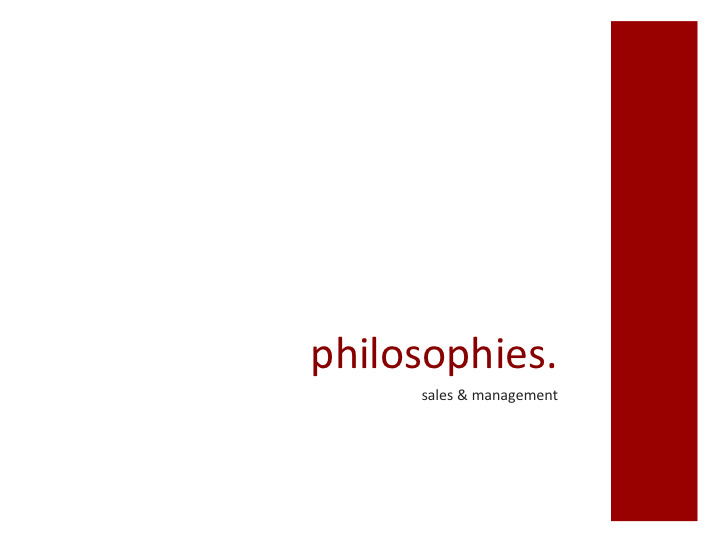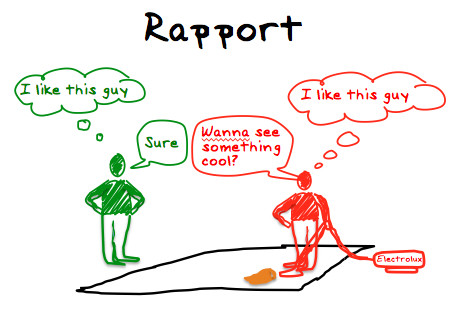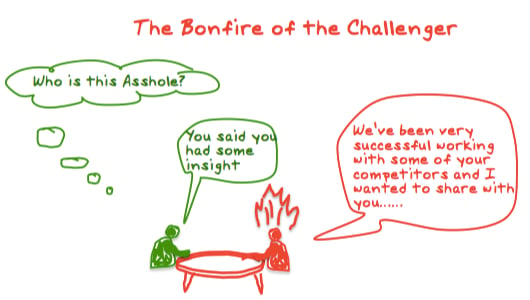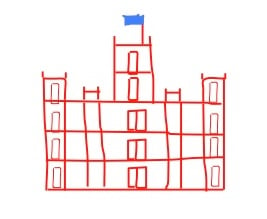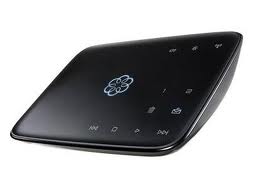8 min read
The Half Life of a Learned Skill is 5 years - Toward a New Culture of Learning
By Mark Gibson on Sat, Apr 11, 2015
Topics: sales training sales learning knowledge john seely brown peter denning
3 min read
Using Visual Storytelling to Get Your Next Job - Case Study
By Mark Gibson on Thu, May 16, 2013
Ever been laid off? I have - and chances are that at some time in your life it could happen to you. Layoff's happen, it's a fact of life in our time and it's no big deal. Companies re-organize, merge, get acquired, have a bad quarter and suddenly, headcount becomes a problem.
After 9-11, there were hundreds of thousands of sales and marketing professionals in the Bay Area suddenly unemployed. Long gone is the era of my parents (grand-parents for many readers), when you joined a company and expected to work a lifetime and retire on a pension at 65.
What happens when you do get laid off? How do you get back into the workforce and perhaps more importantly, how do you win the job you really want, when there are potentially dozens or even hundreds of others applying for the same job? Hint - be different!
Wil Loesel (www.linkedin.com/in/wloesel) worked for Time Warner Cable as a sales manager and was recently laid off due to a restructuring. Wil visited my Website earlier this month and viewed our " Your PowerPoint Presentations Suck Webinar" and decided to apply some of the ideas he learned in the Webinar to differentiate himself in his job search.
Wil's Story
"I had an interview for a B2C Manager position on May 5th. I had prepared a presentation a week earlier for another company I was interviewing at and was working on tailoring it for my interview the next day. I watched your webinar the evening prior to my interview and decided I wanted to change my entire presentation.I stayed up all night (until 8am) revising the presentation. I then slept for 2 hours, woke up and kept working, all the way until my interview. I wrote and memorized talking points and stories for each slide (keeping the slides visual, using only a word or two and a picture) and let my voice present the story."
Wil's Before Slides
There is nothing wrong with Wil's before slides, it's just that they are typical, the same meaningless graphics, too much information and have a memory retention lifecycle for the viewer of one mouse-click.This is one of the worst slides in Wil's old deck, but it's so familiar. I've seen something like this many times and when I see it my eyes glaze over it and move on. The slide below is popular at the moment. I have seen a derivative of this several times at industry conferences and Webinars already this year. It is unreadable and has too much information to be presented effectively.
Wil's After Slides
I have reduced the size of Wil's "after" slides to cover the points in his management philosophy section, because I can... you will still be able to get the key idea from each slide that Wil wanted to discuss, when the slides are shrunk. The images are clean, one main idea per slide, are easily understood and the images create meaning to support his point. It's Wil that is talking, the slides are doing their job as visual aids.
Topics: sales powerpoint visual storytelling
5 min read
2013 - the Beginning of the End of the Gun-Slinger Sales Era
By Mark Gibson on Tue, Dec 04, 2012
This article gained positive comments from industry heavyweights and the essence of Adam's argument was echoed in the Corporate Executive Board's main blog last week, entitled "10 Trends Every Sales Exec Must Know For 2013" This is an important article and worth reading. We have further comments to make to bring the CEB points to life and include the original paragraph and our commentary. Points 2,3,4 are excerpts from the original.
2. Sales culture gets an overhaul.
We can claim this because we are currently studying it, intensely at that. Anecdotally, we’ve seen that organizations heavily invested in driving new selling behaviors through the traditional means of training, coaching, and hiring are seeing some gains but those are often short-lived. The investments these organizations make in driving a new sales behavior are for naught without the right (and, we believe, very different from most) cultural foundation.It’d be a cliché to say that sales culture matters when driving substantial transformation. But when you pry beyond the idea and accepted importance of sales culture, you find little evidence or understanding of what this really means. Social science that can help sales leaders better understand what good sales culture and good social norms look like in today’s selling environment simply does not exist. Frankly, our data is suggesting most sales organizations embodying a cultural profile that overly emphasizes compensation, individual contribution, and near-term outcomes.
We think those cultural norms are a distant cry from what today’s best sales organization should embody. Stay tuned as we have more to come on that front… For our member organizations, be sure to participate in the 2013 Sales Culture and Transformation Survey to understand the cultural profile of your sales organization, and how that is helping or harming your efforts to sell to today’s highly informed customer.
RIP Glengarry Glenross
The culture is broken because the traditional means of training, coaching, and hiring are broken. No other operational area of a business worships such icons as the movie “Glengarry Glen Ross”, fondly repeats clichés like “dialing for dollars” and “sales is a numbers game”, routinely gets away with celebrating reaching 80% of their goal.We agree that models of good sales culture and good social norms in sales organization do not exist. And yes, that most sales organizations embodying a cultural profile that overly emphasizes compensation, individual contribution, and near-term outcomes are critical problems that lead to severely compromised performance, results, job satisfaction, etc.
The fundamental roadblock to driving new sales behaviors and embracing new cultural foundations are very people who should be the agents of this change - today’s sales leaders. They are stubborn, entrenched, selfish, and powerful guardians of the status quo. They, and the ideas that they espouse, stand squarely in the way of a better future for the profession and for the fortunes of their organizations.
Stop the madness...we need drastically new sales training, we need to stop hiring the “Alec Baldwins” (e.g., manipulative, ‘roid rage psychos, lying-cheating-greedy-egocentric types) into sales, we need to sweep out the current crop of sales leaders who have their heads in the sand.
3. Individual performance takes backseat to network performance.
Closely related to trend #2, we believe a fundamentally new organizational dynamic will drive sales productivity – and it’s not based on making individual reps more effective in their sales-related tasks. This trend is based on research our sister team at the Corporate Leadership Council spent the better part of this year conducting. Their publically available research summary is a must read. The punch line of their research is that peak organizational productivity is driven by both:- individual task performance: an employee’s effectiveness at achieving individual tasks and outcomes, as well as
- network performance: an employee’s effectiveness at improving others’ performance and using others’ contributions to improve his or her own performance
In fact, firms that were able to proper balance network and individual performance saw a 10% improvement in profitability. This underscores how important the creation of not just formal, but informal networks within your sales organization is becoming.
In sales environments, CEB suggests that the “right balance” is closer to 44:56 in favor of individual versus network performance. Most sales organizations, however, are nowhere near that ratio, drastically over-representing individual performance.
A Sales Team is an Oxymoron
It’s about freakin’ time that this issue is addressed. The sooner we embrace the fact that there is no such thing as a “sales team”, the sooner we can begin the process of healing and change.Here’s the visual: sled dog team vs. sled cat team
Sales leaders LOVE to use sports analogies to describe sales & sales management. And football tops the list. The problem is that these analogies usually feature the quarterback as the model. We would be far better off if the offensive lineman became the model instead. These guys are the “poster-boys” of balancing:
- individual task performance: an employee’s effectiveness at achieving individual tasks and outcomes, as well as
- network performance: an employee’s effectiveness at improving others’ performance and using others’ contributions to improve his or her own performance
4. Sales comp gets an overhaul.
Related to both trends #1 and #2, we believe the backbone of most sales organizations – the comp plan – is drastically outdated for today’s sales environment.Team performance, information sharing, collaboration and peer support are being forsaken at the cost of driving individual rep productivity. Our good friend and member – Mitch Little, Head of Sales at Microchip – is moving aggressively on this idea and has shifted sales compensation away from the traditional quarterly incentives, highly-variable comp model towards a team performance model that resembles traditional salaried positions.
And Mitch isn’t alone. In fact, I’d say one of the most common questions we’ve been getting from our most progressive heads of sales is on this very topic. I don’t think we are prepared to proclaim an end to the coin-operated era in sales, but all the evidence and research in the space of human motivation sure does signal that comp design needs to be revisited, and not just to tweak it, but to potentially overhaul it.
This is another trend for our members to stay tuned to as both our team and our sister council, the Corporate Leadership Council for Compensation, further research the implications.
Money, Money, Money
It always comes down to money and this is clarion call that harks many people into sales in the first place. Today’s commission-heavy comp plans and other current incentives (spiffs, President's Clubs) are worse than just drastically outdated for today’s sales environment. They are wasteful, divisive, and discouraging. Most (if not all) comp plans merely give lip-service to concepts like team performance, information sharing, collaboration and peer support.And “achievement clubs” do far more damage to an organization than promote achievement.

Topics: B2B selling sales consultative selling training
3 min read
The Newton Klotz Story (An amazing sales story & what you can learn)
By Mark Gibson on Mon, Nov 05, 2012
Actually Adam wrote this one down and quite a few more in a collection of sales stories and what we can learn from them....and we plan to publish them in a book next year.
Introducing Newton Klotz, Electrolux Salesman
One day my Dad calls the local Electrolux store to ask about buying a new hose for his vacuum. The sales guy, Newton Klotz, says, “Sure. I’ve got one of those in my car. About $15. I’ll drive it over...be there in about 15 minutes.” This totally delights my Dad so he says, “Sure, come on over.”Conversations, not Presentations
The Klotzmobile shows up at the house as promised. It’s a well-used Oldsmobile Vistacruiser station wagon jammed full of all sorts of parts and new & used vacuums. He rings the doorbell and greets my Dad with the part he wanted to fix the vacuum, but he also has a brand new, top-of-the-line Electrolux as well.My Dad invites him in and thus begins the amazing stuff I promised you at the beginning. Old Newton is no fool. He knows that my Dad just wanted the new hose...a $15 sale. Not bad, in that selling the new hose is giving the customer exactly what he wants. Good on the karma scale, but not much commission. That only comes with the sale of new vacuums. But instead of launching into a hard sales pitch, our intrepid sales pro starts in on a line of conversation around how the hose wore out, which led to a discussion of lifestyle, kids, home-ownership, sports, you name it. Anything and everything EXCEPT vacuums.
Demonstration and Use of Props
After Newton has established a great deal of rapport with my Dad, he determines it's time to ask permission to do a demonstration.Newton innocently asks my Dad if he wants to see something really cool and amazing. Sure says Dad. Newton throws a pocketful of dirt on the rug at my Dad’s feet. Holy shit!
No worries says Newton and he proceeds to vacuum it up with the aforementioned brand-spanking-new, top-of-the-line unit. Dad is suitably (and predictably) impressed. To make a longer story a bit shorter, old Newton departs after my Dad has bought not one, but two new vacuums! One for upstairs and one for downstairs. Oh, and Newton threw in the new hose “just in case”. Total? Over 900 bucks!!!
- Did Newton pressure my Dad into buying? No.
- Did Newton manipulate my Dad into buying? Nope.
- Did Newton wear my Dad down until he bought just to get him out of the house? Not in the slightest.
Lessons Learned
- Rapport opens the door to sales conversations.
- Seek to understand before opening your mouth about product.
- Seek permission to introduce the product and to demonstrate it.
- Newton had great interpersonal skills, learned and honed through experience and practice, not by memorizing "closing lines".
- Through their conversation, Newton discovered (is learned a better word?) that my Dad really did want two new vacuums. Mind you, I did NOT say that my Dad needed two new vacuums, let alone one. He WANTED them.
- If all Newton did was sell the replacement part, he never would have learned this and made the larger sale.
- If all Newton did was to do the high-pressure sales thing....same result.
- Simply by having a conversation, not a “sales” conversation and not according to some pre-defined “line-of-questioning” put forth by some Sales Process mind you, did all this become possible.

Topics: sales qualification discovery rapport
3 min read
The Bonfire of the Challenger Salesman - my worst sales call
By Mark Gibson on Wed, Oct 31, 2012
Background
MicroStrategy in the late 1990's and early 2000's was successful in selling Business Intelligence software into the retail vertical and had secured a number of high profile retail customers. I had been successful in data warehousing sales at premium supermarket operators on the US West Coat at Safeway and American Stores and had worked with partner NCR in the retail market for the past year.Flush with the success of engineering the biggest deal in MicroStrategy history, an OEM deal to NCR and recent success in the supermarket business at Safeway, we visited the CIO of a rack and stack supermarket operator.
The meeting goal was to introduce MicroStrategy and share how our retail clients were using data warehousing and analytics in their supermarket business using MicroStrategy analytics in partnership with IBM to better manage their inventory, avoid stock-outs and improve margin.
After the greeting formalities, I opened the sales call with an introduction to the recent work we had done in data warehousing at high-end retail customers and the investments they had made and the results they were seeing. I could see the buyer getting uncomfortable in his chair before I had finished my introduction.
He then launched into an angry tirade about how they were a pennies on the dollar retailer and they had no interest in doing what Safeway or anyone else were doing. Their customers wanted to buy groceries at the lowest cost. They had no interest in category management or householding or market-basket analysis. Their business model was to buy low and sell low….at which point he got up and walked out of the meeting….the meeting had lasted less than 5 minutes.
What Happened?
- My selling style has always been assertive and it has at times been deliberately provocative, which is why The Challenger Sale caught my attention.
- In this call on a retailer at the opposite end of the market to my former clients, Safeway and American Stores, I came across as arrogant and condescending in my brilliant and challenging opening.
- The Challenger Sale is great in theory. In practice you need empathy and sensitivity or it can blow up in your face, just like it did for me.
Lessons learned
- Before you open your mouth about product or launch into your Challenger idea, you had better have established rapport to the point the buyer is ready to listen to your message.
- Know your customers business… it was clear that I had not done sufficient homework on the customer….they were technology laggards and data warehousing was still in the early adopter phase. IBM invited us into the meeting, but it was a meeting we should never have attended.
- Empathy is a natural human trait, but for some, it is undeveloped or suppressed due to circumstance and environment and has to learned in a voyage of self-discovery. My wife told me I had no empathy and this call triggered a journey of self discovery, starting with a series of sessions with a psycho-therapist.
- Communication and rapport skills are assumed to be innate for anyone in sales; in reality, most salespeople grossly overestimate their ability to connect at an emotional level and truly listen.
- NLP Practitioner training would be a good start for anyone in sales or presales struggling with empathy, sensitivity or connecting emotionally with others and it will serve them well outside their business life.
Click here for a free trial.
Topics: challenger sale sales soft skills rapport empathy
3 min read
B2B Sales in Turmoil - Who Needs Salespeople?
By Mark Gibson on Fri, Oct 05, 2012
The series continues with a post on the changing perceptions and realities of the sales role in the B2B buying process with Mike Bosworth. Mike Bosworth is the founder of Solution Selling. From Solution Selling, Customer Centric Selling was born. He is the co-founder of Story Leaders in which he provides workshops and executive coaching, helping people learn how to use the powers of story and empathic listening to connect with, inspire, and influence change in others.
The series concludes with a post from Mark Gibson, entitled B2B Sales and Marketing in Transition, What's Working".
The Product is so Strong it Sells Itself!
Guest Post by Mike Bosworth
Actually the above statement is a myth, complex B2B products still need to be sold, but anyone selling today will confess that it's way more difficult than it was 10 or 15 years ago.The buyer is firmly in charge of the buy-sell relationship and the role of a salesperson in many cases is in the facilitation of a buying process.
In a recent Sirius Decisions Perspective, CIO’s interviewed, solved their problems in the following order.
- Leverage search engines by entering the problem I am trying to solve or an initiative I’m considering.
- Explore a known vendor Website.
- Ask my team or colleagues to come back with a series of options.
At this point in the buy cycle, the buyer pretty much knows what they need to solve their problem and who the players are with viable offerings, what remains is to convince top management they made the best decision for the company and were able get the best price from the vendor they emotionally wanted to buy from, their ‘preferred’ vendor.
With the exception of the top 10-15% of salespeople who typically run most deals, this new buying approach excludes salespeople until the buyer is ready to talk to a salesperson.
The members of this elite group of salespeople, who are able to engage earlier in the buy cycle, are the initiators of deals, the instigators of action, the challengers and the status-quo busters, who are able to connect with buyers.
Once connected, they are able to engage in conversation around buyer issues and develop trust and influence through the insight and industry knowledge they bring as trusted advisors first and salespeople second.
Buyers Aren’t Looking for Relationships with Salespeople
All process and competency falls short if pushed on the buyer before there is an emotional connection. Trust comes from an emotional connection first and demonstrated competence second. If buyers feel connected with you, they will allow you to then demonstrate your competence.We have all had occasions over the years to emotionally connect with strangers who are so compelling to us that we say to ourselves, "whatever she is selling, I'm buying!” Bill Clinton is a great example of someone who can emotionally connect with people. Ideally, a salesperson can gain that kind of trust and influence with a buyer before they bring out their offering.
Buyers used to need sellers for information about new products, technology roadmaps and industry trends and they would pretend to be interested in order to get that information.
Today, they do not need the seller for information. When they get a 'touch' opportunity today, salespeople have to have the ability to get the buyer to want to buy from them as human beings.
If you can connect emotionally with buyers and bring insight to the table that truly creates value, you have can have a relationship with any buyer. Is it any wonder that just 13% of sellers are delivering 87% of the revenue? (Sales Benchmark Index).

Topics: sales B2B selling process buying process
4 min read
Downton Abbey - Great Storytelling and its Importance in B2B Selling
By Mark Gibson on Thu, Jan 26, 2012
It's the best TV drama I have seen for a very long time and a welcome departure from the US election news; I'm a huge fan and recommend it to anyone interested in quality entertainment.
For those who have not yet seen Downton Abbey, Series 2 is playing on Masterpiece Theatre on Sunday evening in the US, on the PBS channels.
Downton Abbey has enormous appeal across age groups from 10 years old to 100 and is being shown in 100 viewing territories. It is hugely popular in the US, UK and is the biggest television hit in Spain for 10 years.
Downton Abbey is a beautifully written and visually compelling story from a time of tremedous social upheaval, World War 1. The characters are fully developed; the aristocrats restrained and rule-bound by the mores of the era and the servants, subjugated by dutiful obedience. The superb grounds and the setting of Highclere is stunning.
The essence of great storytelling is our ability to identify and connect with the aspirations and frustrations of the characters in the story as they confront their personal challenges. The tension and excitement in the struggle to overcome them as the story unfolds makes the next episode a compelling must-watch event and a reason for staying in on Sunday evenings.
How can we apply these lessons in selling?
John Kotter, Harvard Business School professor, and author of "Leading Change" who comments on the power of visual storytelling states , "Over the years I have become convinced that we-learn best-and change-from hearing stories that stike a chord within us. Those in leadership positions, who fail to grasp or use the power of stories, risk failure for their comanies and themselves".Salespeople are leaders running their own business franchise and John Kotter's advice is highly relevant.
Top Salespeople are Natural Storytellers
I'm currently working on a whiteboard story for a leading technology company and have received contributions from some of the sales and marketing stars in the company over the course of its development.What struck me about a number of the salespeople and marketing team members is their use of story in discussing their products.
- They use anecdotes and simple, yet powerful metaphors when talking about how their products are used.
- Use cases come alive through examples that are relevant and compelling.
- They create tension in their discussion around the use of their products to differentiate themselves from the competition.
- They have figured out how to tell their story naturally....without a script.
Bottling your Story
Our goal in creating Whiteboards is to capture and bottle the magic from the top performers and create a story around how the products are used to overcome problems with the status-quo and have everyone on the customer-facing team learn it and have fun telling it.When the buyer is at the center of your story vs. your products and the story captures their current situation and their struggle, then you are well positioned to have your capabilities unfold naturally in conversation.
Combining Visual Imagery and Story
The earliest evidence of Visual storytelling is 35,000 years ago in the paleolithic cave paintings in Chauvet Cave, South of France. With the advent of the slide projector and then PowerPoint, we forgot how to tell stories and let the bullets and slides do the talking.The best presentations in sales communication successfully integrate simple images with product value-creation and weave a story around the buyer condition.
When we use whiteboards to tell our story vs. PowerPoint bullets, we use simple hand drawn images (that are immediately meaningful in the context of the discussion), interwoven into a story around issues that the buyer is potentially struggling to overcome.
In a WhiteboardSelling enablement symposium, everyone on the customer-facing team learns to draw the whiteboard and to tell their story and in half a day, they will have learned the story well enough to use it with prospective customers the next day...although they may be somewhat uncomfortable until they have mastered it.
There is massive difference in the level of cognition in the audience between an un-trained novices scrawled notes on a whiteboard and the whiteboard created by a person trained to present a visual story and to use icons to convey meaning.
Buyers will often remember a well constructed whiteboard story months after the interaction; scrawled notes on a whiteboard will not be stored in our brain in the same way a poor PowerPoint presentation is discarded from our memory.
Take-Aways:
- The essence of selling is effective communication and the most effective communication uses simple visual images interwoven into a story.
- For those who enjoy British humor, a spoof of Downton Abbey for last year's Red Nose Day charity fundraising event is hilarious. Links below.
http://www.youtube.com/watch?v=r5dMlXentLw
http://www.youtube.com/watch?v=p3YYo_5rxFE - PBS Interview with the producer and cast members
- Learn more about the science behind WhiteboardSelling Enablement.
Topics: sales downton abbey sales & Marketing effectiveness visual storytelling
4 min read
Selling from Home - Here's an Updated Sales Communications Setup
By Mark Gibson on Wed, Feb 23, 2011
Selling from a Home Office
I've been working from a home office since 1995 and have had a variety of communication set-ups and have tried a number of different telephone service providers including Pac-Bell, Sprint, Nextel, British Telecom and T-Mobile.In setting up my new home office, I had planned to use my cellphone as my only phone with T-Mobile— they have an all you can eat voice and data plan that is (un)reasonable...but I'm stuck with it. Unfortunately the signal in my office is very poor and a non-starter for professional communication, so I needed a plan "B".
Quality Matters
When I ordered the Internet service I went to the local cable company, Comcast, as they have upgraded their technology and service level and offer a competitive introductory rate for broadband. I declined their phone service at $60 per month however as I knew I could install VOIP myself for a lot less.I had used Vonage for six months and Skype for about six years in the UK and tried Skype here for a few months, investing in a high quality USB microphone and a noise cancelling headset, but found voice quality very choppy and plenty of times would just get cut off or the sound quality was not good enough for sales conversations.
It's hard enough to get someone on the phone — when you do, static on the line and garbled communication is intolerable. I was spending about $40 per month on the Skype service and was not happy with service, although Skypetogo was useful in speaking with overseas family members on my cellphone for the price of a local call when out of the office on my cell.
Ooma Telo
I did some homework on DECT phonesto connect to the VOIP system and went my local BestBuy to buy a set and get a couple of recommendations on VOIP. After more homework I opted for the Ooma Telo VOIP system at the basic level and paid just over $200 for the device. The Ooma Telo system (pictured) gives you unlimited phone calls in the US and you pay a fee in advance for International calls at similar International rates to Skype (1.5 cents/minute), but there is no monthly fee, except for local taxes - about $3.00 per month in my case.
Integrated Bluetooth Headset and Mobile
I bought a Bluetooth enabled Panasonic KX-TG6581 DECT 6.0 system with a desk unit and 2 handsets...this is a great phone, optional upgrades are a DECT repeater and extra handsets.Already the owner of the excellent over the ear Plantronix Voyager Pro Bluetooth headset with a boom microphone, I paired this with the handset.
I installed the Ooma system, connected up the DECT phone in about 10 minutes and after the new number was provisioned, started making calls within an hour....crystal clear calls.
I've had the system for over 9 months now and the quality is excellent most of the time (which is the same for most VOIP providers), my cell phone usage has dropped in half and I have renegotiatied my rate down with T-Mobile. The ROI on this total investment was less than 6 months. If I had been using Comcast phone services my ROI would have been less than 3 months. The Bluetooth on the Panasonic supports my Android mobile phone so that when a call comes in on my mobile I can pick it up on the Panasonic DECT system.
Take-aways
1. There is no room for compromise in quality of your voice communication when selling over the phone .2. The Ooma Telo system works great and will pay for itself in months.
3. Bluetooth headsets have come a long way and I wear the Voyager Pro all day...I dont even notice it is there.
4. The Panasonic DECT 6.0 phones have a long battery life, work extremely well with Bluetooth and have everything you need.
Addendum
Since writing this article I have added my old Polycom Soundpoint Pro speakerphone into the mix as I record a lot of my whiteboard messaging conference calls and wanted the best possible audio reproduction. I simply added a split jack onto the analog port on the back of the Ooma.The sound quality on this analog speakerphone is unbeatable.
I also highly recommend the Roland R-05 voice recorder from The Sound Professionals. I have bought a ton of professional recording gear from them over the years and found them to be an excellent source of high quality gear and sound advice. The one in the image has superseded the unit I am using, but I use it in nearly every meeting as it is extremely valuable to have a recording to refer back to when a reference is needed and weeks have passed since the conversation.



